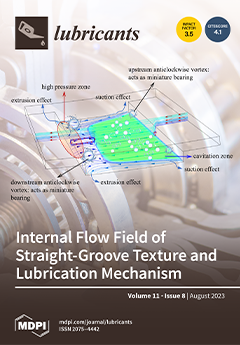Automotive formulated lubricants are high value products composed of 80% base oil and 20% various additives. During their life service, lubricants are exposed to several factors that will cause degradation over time, such as high temperature, shear, and oxidation. Base oil is a
[...] Read more.
Automotive formulated lubricants are high value products composed of 80% base oil and 20% various additives. During their life service, lubricants are exposed to several factors that will cause degradation over time, such as high temperature, shear, and oxidation. Base oil is a complex combination of hydrocarbons that are relatively sensitive to oxidation. During the initiation phase of oxidation, free radicals are formed, leading to the production of hydroperoxide ROOH and an alkyl radical R
•. These compounds will react with the base oil molecules to form aldehydes, ketones, and carboxylic acids in the termination phase. Owing to the molecular complexity of these mixtures, Fourier transform mass spectrometry seems to be the most appropriate tool to cover their wide range of compounds due to its ultra-high resolving power and mass accuracy. In this study, a native formulated lubricant and its different oxidized states at 140 °C under air flow (3, 5, 7, 8, and 9 days of oxidation) were analyzed by FTICR MS. The combination of atmospheric pressure chemical ionization (APCI) was used to achieve a non-selective ionization of molecules, including base oils, while Electrospray ionization (ESI) was used to selectively ionize acidic molecules. Apparent Kendrick mass defect (aKMD) plots were used to separate homologous series of molecules on different horizontal lines on the basis of the CH
2 repetition unit. Aging of lubricants was mainly characterized by a rapid consumption of certain additive families, such as molybdenum dithiocarbamates (MoDTCs) and zinc dithiophosphate (ZnDTPs), but also by the emergence of many oxidation products. Thus, the presence of aldehydes, ketones, and acids was characterized in the early stage of aging while larger products from polymerization were observed in a more advanced stage of aging. Interaction products between peroxy radicals and hindered phenols/alkyl diphenylamines (ADPAs) antioxidations were elucidated toward the high
m/z. The formation of such products can be explained by trapping mechanisms of these additives at high temperature (>120 °C). Other types of interaction products were observed with the formation of antioxidant complexes. Additive degradation products were also characterized. For instance, polyisobutenyl succinimide dispersant oxidation products were clearly evidenced on the aKMD plots due to the gaps of 56 Da between each point. Overall, this study demonstrated the efficiency of the aKMD approach, and the use of ESI/APCI to characterize base oil and additive oxidation products.
Full article





